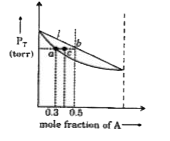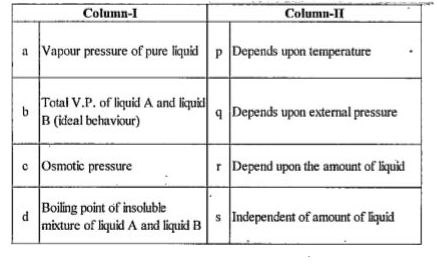Statement 1: The process of mixing of CH3OHandCCl4 is accompanied by increase in enthalpy and is a spontaneous process.
Statement 2: When CCl4andCH3OH are mixed, weaker forces of attraction are replaced by stronger force of attraction.Solution in Malayalam
Statement 1 is True, Statement 2 is true, Statement 2 is correct explanation for Statement 1
Statement 1 is True, Statement 2 is True, Statement 2 is NOT a correct explanation for Statement 1
Statement 1 is True, Statement 2 is False
Statement 1 is False, Statement 2 is True
The correct Answer is:D
The process of mixing of CClandCH3OH is accompanied by decrease in enthalpy.
Topper's Solved these Questions
- BOOK - BRILLIANT PUBLICATIONCHAPTER - SOLUTIONSEXERCISE - Level-III (Linked Comprehension Type)12videos
SOLUTIONS
- BOOK - BRILLIANT PUBLICATIONCHAPTER - SOLUTIONSEXERCISE - Level-III (Matching Column Type)5videos
SOLUTIONS
- BOOK - BRILLIANT PUBLICATIONCHAPTER - SOLID STATEEXERCISE - LEVEL-3 (Linked Comprehension Type)10videos
SOLID STATE
- BOOK - BRILLIANT PUBLICATIONCHAPTER - STEREOCHEMISTRY EXERCISE - LEVEL-II (ASSERTION - REASON TYPE)2videos
STEREOCHEMISTRY
Similar Questions
1 mole of A and 1 mole B are mixed together to form an ideal solution at 25∘C. Solution is placed in a vessel fitted with piston. If pressure on the solution is reduced isothermally.

Correct relationship between P∘AandP∘B is02:16View SolutionMatch the columns
 03:22View Solution
03:22View SolutionF centre is an example of metal excess defect due to the presence of extra cations at interstitial sites. Zinc oxide is white in colour at room temperature, on heating it loses oxygen and turns yellow.
ZnOHeat−−→Zn2++12O2+2e−
Now there is excess of zinc in the crystal and its formula becomes Zn1+x O. the excess of Zn2+ ions move to interstitial sites and the electrons to neighbouring interstitial sites.
There are many solids which are difficult to prepare in the stiochiometric composition and contain less amount of the metal as compared to stiochiometric proportion. a typical example of this type is FeO which is mostly found with a composition of Fe0.95. it may actually range from Fe0.96 O.
Q. In Fe0.95 O:View SolutionAssertion : Meso tartaric acid is optically inactive
Reason : Meso tartaric acid has a plane of symmetry03:19View SolutionConsider the following reaction, (CH_(3))_(3)C-Cl+OHrarr(CH_(3))_(3)C-OH+Cl^(-) The true statement about the above process is
09:24View SolutionWhen CH3OH(l) is mixed in water:
05:38View SolutionThe compound (CH3)2.OH∣CCCl3 is
View SolutionEnthalpy change of CH_(4)+(1)/(2) O_(2) rarr CH_(3) OH is negative . If enthalpy of combustion of CH_(4) and CH_(3)OH are x and y respectively, then which relation is correct ?
04:57View SolutionCH4,CH3Cl,CH2Cl2,CHCl3 एवं CCl4 में कार्बन की ऑक्सीकरण संख्याएँ बताइए ।
View Solutionनिम्नलिखित में सहसंयोजक बंधन बनने कि प्रक्रिया का वर्णन करें -
HCl,CCl4,CH4,O2 और Cl2View SolutionArrange the following illustration in order of increasing acidity : (i) HCOOH, ClCH_(2)COOH , CH_(3)COOH (ii) CH_(3)COOH , (CH_(3))_(2) CHOOH , (CH_(3))_(3)C CO OH (iii) ClCH_(2)C O OH , Cl_(2)CHO OH , CH_(3)CO OH . (iv) ClCH_(2)CO OH , CH_(3)CH_(2)COOH , ClCH_(2)CH_(2)COOH , (CH_(3))_(2) CHOCOOH, CH_(3)COOH (V) CH_(3)COOH , Cl_(2)CHCOOH , CH_(3)CH_(2)COOH , Cl_(2)C COOH , ClCH_(2)COOH .
02:55View SolutionEnthalpy of CH4+12O2→CH3OH is negative. If enthalpy of combustion of CH4andCH3OH are x and y repectively. Then which relation is correct ?
View SolutionWrite IUPAC and common name of the following: (i) CH_(2)OH- CH_(2)-CH_(2)OH (ii) CH_(2)OH- CHOH - CH_(2)OH (iii) CHO- CHO (iv) Cl- CH_(2)-COOH (v) CH_(3)COOCH_(3) (vi) CH_(3)COO CH_(2)CH_(3) (vii) HCOOH (viii) COOH-COOH (ix) CH_(2)Cl_(2) (x) CHCl_(3) (xi) CHCl_(2) C Cl_(3)
03:59View SolutionWrite IUPAC and common name of the following: (i) CH_(2)OH- CH_(2)-CH_(2)OH (ii) CH_(2)OH- CHOH - CH_(2)OH (iii) CHO- CHO (iv) Cl- CH_(2)-COOH (v) CH_(3)COOCH_(3) (vi) CH_(3)COO CH_(2)CH_(3) (vii) HCOOH (viii) COOH-COOH (ix) CH_(2)Cl_(2) (x) CHCl_(3) (xi) CHCl_(2) C Cl_(3)
02:16View SolutionCH3−C≡C−CH2−CH3+Cl2CCl4−−→ उत्पाद है :
02:51View SolutionCH3−C≡C−CH3+Cl(1.eq.)CCl4−−→ उत्पाद है :
03:04View Solution

